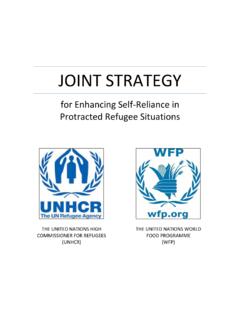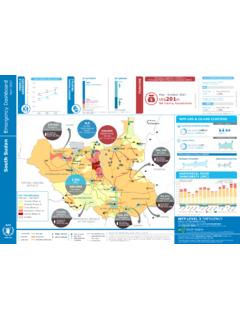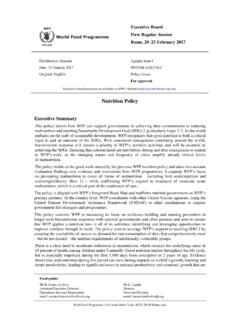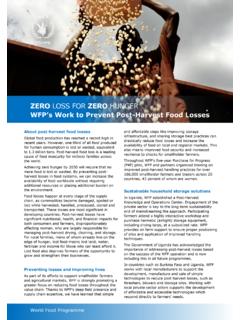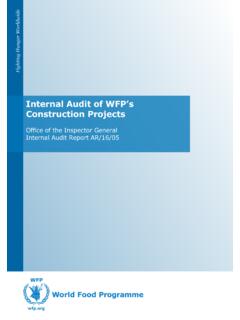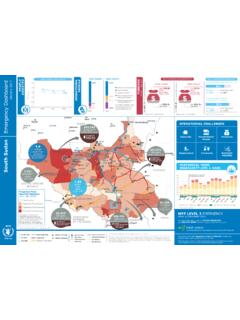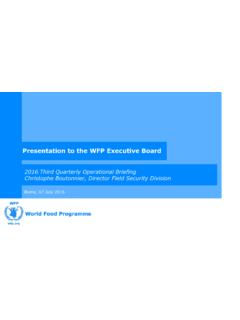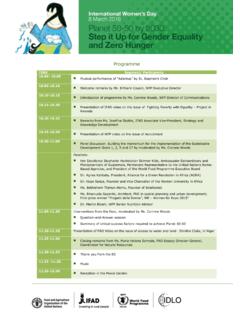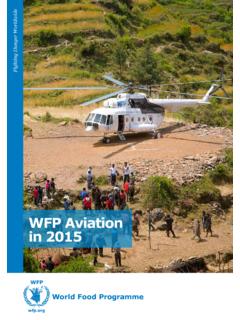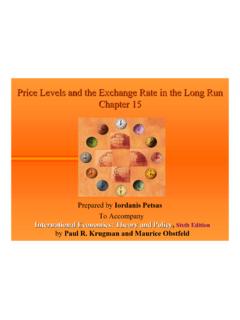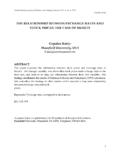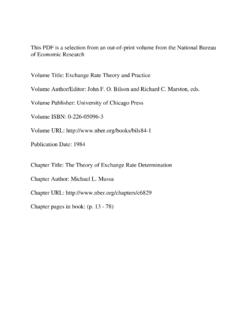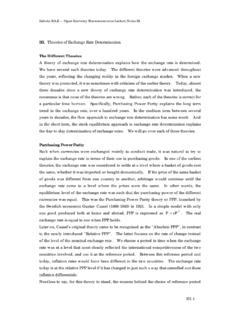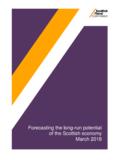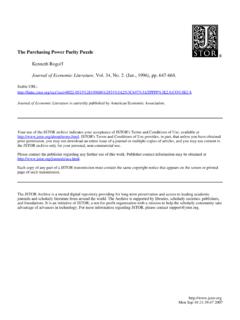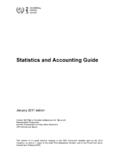Transcription of WFP sOUTH SUDAN MARKET PRICE monitoring …
1 WFP sOUTH SUDAN MARKET PRICE monitoring BULLETIN 1- 30 April 2016 MARKET Highlights The US$/SSP exchange rates exhibited daily fluctuations for the better part of April 2016. The local currency gained slight ground against the USD in the intervening period of signing of the Compromise Peace Agreement in the last two weeks of April, only to resume loosing trends thereafter and was exchanging at SSP 36-39/1$ in third week of May in the black MARKET . The persistent shortage of dollars continued to dis-incentivize imports into the country during the reporting month. The fuel crisis, characterized by shortages, hoarding and informal sale on road sides at inflated costs, continued for the fifth straight month in 2016, disrupting road movements and trade.
2 In the black MARKET , diesel costed as high as SSP 150/litre in Bentiu, Bor and Malakal but was slightly lower in Juba (SSP 70-100). The nominal prices of sorghum, maize, beans, cooking oil and wheat flour continued rising trends in most markets and are significantly higher than their levels a year ago and the long-term mean. The prices of white sorghum, for instance were highest in Wau and Kuajok, going for as much as SSP 88 and 95/malwa1, respectively during the reporting month. In the May-July period, prices of staple foods are expected to continue rising to peak in July while purchasing power will be reduced for many households in line with lean seasonal trends.
3 The dollar and fuel crisis is likely to persist as most areas become inaccessible during the rainy season, further limiting trader s stocking capacity. The formation of the Transitional Government of National Unity (TGoNU) signals positive prospects for recovery of livelihoods, trade and MARKET infrastructure but the economic gains are unlikely to be instant. The high food prices will limit household s access to food and as a consequence heighten seasonal vulnerability to food insecurity among MARKET -dependent populations especially the urban poor and those with huge consumption gaps in rural areas. 1 container 1 | P a g e WFP sOUTH SUDAN MARKET PRICE monitoring BULLETIN I.
4 High cost of living restricting access to food In April 2016, the cost of food sustained rising trends. At SSP 4,900, the Minimum Food Basket Cost2 (MFBC) rose by 10% compared to the previous month, by 62% over the last three months and by 260% compared to the same month in 2015 (Figure 1). Due to high food prices and depleted assets, many urban poor and vulnerable populations in rural areas, which are highly reliant on the MARKET economy, are finding it increasingly difficult to afford food and are therefore facing increased destitution amidst stagnant incomes. The worsening food insecurity situation, localized insecurity and high cost of living has forced many households to flee into SUDAN , Uganda, Kenya and the Democratic Republic of the Congo (DRC).
5 As of 25 April 2016, UNHCR and OCHA sOUTH SUDAN reported that about 69,000 people (predominantly from Northern Bahr el Ghazal & parts of Warrap) had crossed into SUDAN , about 28,000 had sought refuge in Uganda, some 23,000 mostly from Western Equatoria had crossed into the DRC, while 4,185 had arrived at Kakuma camp in Kenya3 since the beginning of the year. This flight in projected to continue at least until the next harvests. II. Economic instability limiting food imports The ongoing economic crisis continued to limit importation of food and fuel availability across the country. Currency devaluation and shortage of dollars has increased the cost of importing food, discouraging traders and reducing import volumes.
6 For example, traders in Warawar, Northern Bahr el Ghazal indicated in the previous MARKET assessment (March 2016) that the weakening of the SSP against the US$, the scarcity of hard currency and closing of the border had made it difficult for them to import commodities from SUDAN . Even though the SSP gained slight ground against the US$ in the intervening period of signing of the Compromise Peace Agreement in the last two weeks of April, the reprieve was only short-lived as the local currency has since resumed loosing trends. The US$ exchanged at an average of SSP 33 in April, up from SSP 45 earlier, but has since lost ground in second week of May, going for SSP 36-39/1$ in the alternative black MARKET .
7 The official exchange rate has been pegged within stable bands by the Bank of sOUTH SUDAN at SSP 30/1 US$ during the reporting month. 2 Basic staple (sorghum or maize), pulses/beans (source of protein), vegetable oil, sugar and salt. This provides the cheapest possible minimum food basket for minimum energy requirements consumed by an average household of six people. 3 SS OCHA Humanitarian Bulletin, 9 May 2016 - 2: exchange Rates (SSP/USD):official vs. Parallel MARKET rateOfficial exchange Rate768 1,041 869 954 1,114 1,352 2,267 2,076 2,495 3,006 3,530 4,450 4,860 - 1,000 2,000 3,000 4,000 5,000 6,000 AprAug-SepJan-marMay-JulyOct-DecAprAug-S epMay-JulyOct-DecJanFebMarApr20142015201 6 Figure 1: Trends in Minimum Food Basket Cost (FBC) 2 | P a g e WFP sOUTH SUDAN MARKET PRICE monitoring BULLETIN III.
8 Hoarding of fuel disrupts trade, movement and commodity flows Hoarding of fuel supplies alternated with a vibrant black MARKET extended for the better part of 2016 throughout the country in response to massive long-run fuel shortages. Dollar scarcity, currency devaluation and weak management of international fuel procurement were the main reasons behind persistent fuel crisis. In April, the fuel shortages continued to hit most of the states for the fifth month in a row, disrupting trade, road movement and lowering import supplies. Markets in Warrap and Maban had the highest prices of diesel during the reporting month, varying from SSP 35 to 40 /litre in petrol stations.
9 The black MARKET prices of fuel were fivefold those of the official rates. In Juba for example, fuel costed SSP 70 to 100 /litre in the black MARKET in April while the official fuel cost was pegged at SSP22/ litre. The black MARKET going rates were even higher in some areas like Rumbek, Awiel and Wau while in the Greater Upper Nile areas such Bentiu, Bor and Malakal, the supply was very low and fuel costed as much as SSP 150/litre in the black MARKET . MARKET supplies remain limited across many markets on the backdrop of depleted household food stocks, reduced trade flows and constrained road movements In April 2016, cereal (maize & sorghum) prices surged upwards in most markets compared to the previous month and were significantly higher than during the same time last year and the five year average.
10 The highest costs of sorghum were observed in Kuajok and Wau as the malwa stood at SSP 88-95 (Figure 4). Similarly, white sorghum prices increased in Yida, Maban and Bentiu to SSP 50 to 70 malwa. Bor MARKET recorded the highest PRICE increment for sorghum (60%), while also rising (11-50%) in Kuajok and Yambio respectively. At the same time, sorghum prices in Juba were slightly lower than the previous month but were still elevated compared with the same month in 2015 (43%) and the 5-year average (259%). Low supply or absence of white maize was reported in Aweil, Bor and Maban. The nominal retail prices of white maize in April 2016 recorded an increase of 65% in Kapoeta sOUTH MARKET (retailing at SSP 59/malwa) and also by 38% in Yambio (costing SSP 45/malwa).
